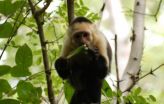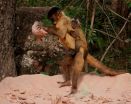(Press-News.org) Figuring out how to survive on a lean-season diet of hard-to-reach ants, slugs and other bugs may have spurred the development of bigger brains and higher-level cognitive functions in the ancestors of humans and other primates, suggests research from Washington University in St. Louis.
"Challenges associated with finding food have long been recognized as important in shaping evolution of the brain and cognition in primates, including humans," said Amanda D. Melin, PhD, assistant professor of anthropology in Arts & Sciences and lead author of the study.
"Our work suggests that digging for insects when food was scarce may have contributed to hominid cognitive evolution and set the stage for advanced tool use."
Based on a five-year study of capuchin monkeys in Costa Rica, the research provides support for an evolutionary theory that links the development of sensorimotor (SMI) skills, such as increased manual dexterity, tool use, and innovative problem solving, to the creative challenges of foraging for insects and other foods that are buried, embedded or otherwise hard to procure.
Published in the June 2014 Journal of Human Evolution, the study is the first to provide detailed evidence from the field on how seasonal changes in food supplies influence the foraging patterns of wild capuchin monkeys.
The study is co-authored by biologist Hilary C. Young and anthropologists Krisztina N. Mosdossy and Linda M. Fedigan, all from the University of Calgary, Canada.
It notes that many human populations also eat embedded insects on a seasonal basis and suggests that this practice played a key role in human evolution.
"We find that capuchin monkeys eat embedded insects year-round but intensify their feeding seasonally, during the time that their preferred food – ripe fruit – is less abundant," Melin said. "These results suggest embedded insects are an important fallback food."
Previous research has shown that fallback foods help shape the evolution of primate body forms, including the development of strong jaws, thick teeth and specialized digestive systems in primates whose fallback diets rely mainly on vegetation.
This study suggests that fallback foods can also play an important role in shaping brain evolution among primates that fall back on insect-based diets, and that this influence is most pronounced among primates that evolve in habitats with wide seasonal variations, such as the wet-dry cycles found in some South American forests.
"Capuchin monkeys are excellent models for examining evolution of brain size and intelligence for their small body size, they have impressively large brains," Melin said. "Accessing hidden and well-protected insects living in tree branches and under bark is a cognitively demanding task, but provides a high-quality reward: fat and protein, which is needed to fuel big brains."
But when it comes to using tools, not all capuchin monkey strains and lineages are created equal, and Melin's theories may explain why.
Perhaps the most notable difference between the robust (tufted, genus Sapajus) and gracile (untufted, genus Cebus) capuchin lineages is their variation in tool use. While Cebus monkeys are known for clever food-foraging tricks, such as banging snails or fruits against branches, they can't hold a stick to their Sapajus cousins when it comes to theinnovative use and modification of sophisticated tools.
One explanation, Melin said, is that Cebus capuchins have historically and consistently occupied tropical rainforests, whereas the Sapajus lineage spread from their origins in the Atlantic rainforest into drier, more temperate and seasonal habitat types.
"Primates who extract foods in the most seasonal environments are expected to experience the strongest selection in the 'sensorimotor intelligence' domain, which includes cognition related to object handling," Melin said. "This may explain the occurrence of tool use in some capuchin lineages, but not in others."
Genetic analysis of mitochondial chromosomes suggests that the Sapajus-Cebus diversification occurred millions of years ago in the late Miocene epoch.
"We predict that the last common ancestor of Cebus and Sapajus had a level of SMI more closely resembling extant Cebus monkeys, and that further expansion of SMI evolved in the robust lineage to facilitate increased access to varied embedded fallback foods,necessitated by more intense periods of fruit shortage," she said.
One of the more compelling modern examples of this behavior, said Melin, is the seasonal consumption of termites by chimpanzees, whose use of tools to extract this protein-rich food source is an important survival technique in harsh environments.
What does this all mean for hominids?
While it's hard to decipher the extent of seasonal dietary variations from the fossil record, stable isotope analyses indicate seasonal variation in diet for at least one South African hominin, Paranthropus robustus. Other isotopic research suggests that early human diets may have included a range of extractable foods, such as termites, plant roots and tubers.
Modern humans frequently consume insects, which are seasonally important when other animal foods are limited.
This study suggests that the ingenuity required to survive on a diet of elusive insects has been a key factor in the development of uniquely human skills:
It may well have been bugs that helped build our brains.
INFORMATION:
To read the full study, click here.
http://www.sciencedirect.com/science/article/pii/S004724841400044X
Insect diet helped early humans build bigger brains, study suggests
Quest for elusive bugs spurred primate tool use, problem-solving skills
2014-07-02
ELSE PRESS RELEASES FROM THIS DATE:
UCLA addresses 'lost in translation' issues in Chinese medicine
2014-07-02
Millions of people in the West today utilize traditional Chinese medicine, including acupuncture, herbs, massage and nutritional therapies. Yet only a few U.S. schools that teach Chinese medicine require Chinese-language training and only a handful of Chinese medical texts have so far been translated into English.
Given the complexity of the language and concepts in these texts, there is a need for accurate, high-quality translations, say researchers at UCLA's Center for East–West Medicine. To that end, the center has published a document that includes a detailed discussion ...
Only 25 minutes of mindfulness meditation alleviates stress
2014-07-02
PITTSBURGH—Mindfulness meditation has become an increasingly popular way for people to improve their mental and physical health, yet most research supporting its benefits has focused on lengthy, weeks-long training programs.
New research from Carnegie Mellon University is the first to show that brief mindfulness meditation practice – 25 minutes for three consecutive days – alleviates psychological stress. Published in the journal Psychoneuroendocrinology, the study investigates how mindfulness meditation affects people's ability to be resilient under stress.
"More and ...
UTMB study shows testosterone therapy does not increase heart attack risk
2014-07-02
Testosterone prescriptions for older men in the United States have increased more than three-fold over the past decade. Recent studies linking testosterone use with increased risk of heart attack and stroke have caused widespread concern among patients and their families. A new U.S.-based study of more than 25,000 older men shows that testosterone therapy does not increase men's risk for heart attack.
The study, conducted by researchers at the University of Texas Medical Branch at Galveston, examined 25,420 Medicare beneficiaries 66 years or older treated with testosterone ...
Putting a price tag on the 2° climate target
2014-07-02
Addressing climate change will require substantial new investment in low-carbon energy and energy efficiency – but no more than what is currently spent on today's fossil-dominated energy system, according to new research from the International Institute for Applied Systems Analysis (IIASA) and partners.
To limit climate change to 2° Celsius, low-carbon energy options will need additional investments of about US $800 billion a year globally from now to mid-century, according to a new study published in the journal Climate Change Economics. But much of that capital could ...
Hazardous drinking in UK athletes linked with alcohol industry sponsorship
2014-07-02
New research from the University of Manchester (UK) and Monash University (Australia) shows a link between alcohol sponsorship and hazardous drinking in UK athletes.
The study, published online today in the scientific journal Addiction, is the first to examine alcohol sponsorship of athletes in the UK, and comes at a time when there are calls in the UK, Ireland, Australia, New Zealand, and South Africa for greater restriction or bans of alcohol sponsorship and advertising in sport.
Researchers surveyed more than 2000 UK sportspeople from universities in the North West, ...
More people means more plant growth, NASA data shows
2014-07-02
Ecologist Thomas Mueller uses satellite data to study how the patterns of plant growth relate to the movement of caribou and gazelle. The research sparked an idea: Would the footprint of human activity show up in the data?
Mueller, of the University of Maryland in College Park (now at the Biodiversity and Climate Research Center in Frankfurt) teamed up with university and NASA colleagues to find out. Their new analysis shows that on a global scale, the presence of people corresponds to more plant productivity, or growth.
Specifically, populated areas that have undergone ...
Wind shear wipes out Tropical Cyclone Elida
2014-07-02
Strong northwesterly wind shear took its toll on Tropical Storm Elida, weakening it to a remnant low early on July 2. In infrared satellite imagery from NOAA's GOES-West satellite, Elida appeared to be a tight swirl of low clouds devoid of any deep convection.
Infrared satellite instruments are used to see the heat objects emit. During night-time hours when there's no sunlight to light clouds, satellites like NOAA's Geostationary Operational Environmental Satellite or GOES-West satellite looks at clouds in infrared light. Infrared data from NOAA's GOES-West satellite ...
Georgia Tech researchers develop 'Encore' to monitor Web access
2014-07-02
Georgia Tech researchers have created a tool to monitor the accessibility of Web pages around the world that can be installed by adding a single line of code to a web page. The tool, Encore, runs when a user visits a website where the code is installed and then discreetly collects data from potentially censored sites.
The researchers hope the data they collect will allow them to determine the wheres, whens and hows of what's blocked, as well as identify ways to get around restricted access.
"Web censorship is a growing problem affecting users in an increasing number ...
NASA's TRMM satellite spots heavy rainfall around Tropical Storm Arthur's center
2014-07-02
Tropical Storm Arthur appears to be ramping up, and NASA's Tropical Rainfall Measuring Mission or TRMM satellite spotted heavy rainfall occurring around the storm's center on July 1 when it was centered over the Bahamas.
Those heavy rains are expected to affect the southern U.S. coastline over the next several days as the National Hurricane Center expects Arthur to strengthen into a hurricane. On July 2, the NHC issued a Hurricane Watch for Bogue Inlet to Oregon Inlet, North Carolina and Pamlico Sound. In addition, a Tropical Storm Watch is in effect for the east coast ...
NASA sees a weaker Tropical Storm Douglas
2014-07-02
NASA's Aqua satellite captured a picture of Tropical Storm Douglas as it began moving into cooler waters in the Eastern Pacific Ocean. Those cooler waters, coupled with drier air are expected to bring about the storm's demise, according to the National Hurricane Center.
A visible image of Tropical Storm Douglas was taken by the Moderate Resolution Imaging Spectroradiometer or MODIS instrument aboard NASA's Aqua satellite on July 1 at 21:20 UTC (5:20 p.m. EDT). The thickest band of thunderstorms appeared over the southern semi-circle of the weakening storm while bands ...
LAST 30 PRESS RELEASES:
Scalable and healable gradient textiles for multi‑scenario radiative cooling via bicomponent blow spinning
Research shows informed traders never let a good climate crisis go to waste
Intelligent XGBoost framework enhances asphalt pavement skid resistance assessment
Dual-function biomaterials for postoperative osteosarcoma: Tumor suppression and bone regeneration
New framework reveals where transport emissions concentrate in Singapore
NTP-enhanced lattice oxygen activation in Ce-Co catalysts for low-temperature soot combustion
Synergistic interface engineering in Cu-Zn-Ce catalysts for efficient CO2 hydrogenation to methanol
COVID-19 leaves a lasting mark on the human brain
Scientists use ultrasound to soften and treat cancer tumors without damaging healthy tissue
Community swimming program for Black youth boosts skills, sense of belonging, study finds
Specific depressive symptoms in midlife linked to increased dementia risk
An ‘illuminating’ design sheds light on cholesterol
Who is more likely to get long COVID?
Study showcases resilience and rapid growth of “living rocks”
Naval Research Lab diver earns Office of Naval Research 2025 Sailor of the Year
New Mayo-led study establishes practical definition for rapidly progressive dementia
Fossil fuel industry’s “climate false solutions” reinforce its power and aggravate environmental injustice
Researchers reveal bias in a widely used measure of algorithm performance
Alcohol causes cancer. A study from IOCB Prague confirms damage to DNA and shows how cells defend against it
Hidden viruses in wastewater treatment may shape public health risks, study finds
Unlock the power of nature: how biomass can transform climate mitigation
Biochar reshapes hidden soil microbes that capture carbon dioxide in farmland
Reducing saturated fat intake shows mortality benefit, but only in high-risk individuals
Manta rays create mobile ecosystems, study finds
Study: Mixed results in using lipoic acid to treat progressive multiple sclerosis
Norbert Holtkamp appointed director of Fermi National Accelerator Laboratory
New agentic AI platform accelerates advanced optics design
Biologists discover neurons use physical signals — not electricity — to stabilize communication
Researchers discover that a hormone can access the brain by hitchhiking
University of Oklahoma researcher awarded funding to pursue AI-powered material design
[Press-News.org] Insect diet helped early humans build bigger brains, study suggestsQuest for elusive bugs spurred primate tool use, problem-solving skills







